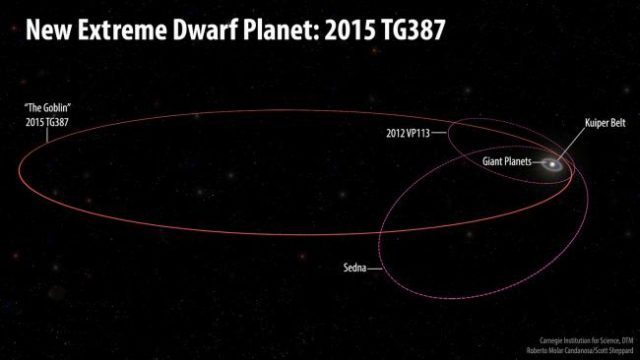A team of American astronomers has discovered a dwarf planet barely 300 kilometers in diameter in the border of the outer solar system. If the average distance between the Earth and the Sun is 150 million kilometers, the new object is never less than 65 times that distance and gets to multiply 2,300 times. The planet, with the abstruse technical name of 2015 TG387, has been baptized “The Goblin” by its discoverers because it was observed for the first time days before Halloween.

“We think there may be thousands of small objects like 2015 TG387 at the limits of the Solar System, but the distance makes finding them very difficult”, astronomer David Tholen, of the University of Hawaii (USA), said in a statement. The diameter of Pluto, another much closer dwarf planet, is about 2,370 kilometers. The Goblin was first detected on October 13th, 2015 from a telescope located on the Hawaiian volcano Mauna Kea. The discovery was made public Monday in a bulletin of the International Astronomical Union.
The importance of the new dwarf planet is that the peculiarities of its orbit support the existence of another planet much larger, with a size 10 times that of Earth, located far beyond Pluto as stressed by the team headed by Scott Sheppard, of the Carnegie Institute, in Washington. The gravitational pull of that hypothetical super-Earth would explain the movements of The Goblin, which takes 40,000 years to go around the Sun.
2 years ago, astronomers Konstantin Batygin and Michael E. Brown, from the California Institute of Technology, already postulated the existence of this great planet, which would be the 9th in the Solar System, after Mercury, Venus, Earth, Mars, Jupiter, Saturn, Uranus, and Neptune. They named it Planet Nine or Planet X, after detecting its presumed effect in the orbits of 6 bodies located in the Kuiper belt, a mare-magnum of icy objects beyond Neptune.
“Planet X seems to affect 2015 TG387 in the same way as other extremely distant objects in the solar system. The simulations do not show that there is another massive planet in our solar system, but they are another indication that there may be something big there”, said astronomer Chad Trujillo of the University of Northern Arizona.
The astronomer Guillem Anglada, who has not participated in this research, gives credibility to the new finding, pending publication in the specialized journal The Astronomical Journal. “It is difficult to screw up detections of this type, as they are easy to verify,” he says. Anglada, a professor at Queen Mary University in London, discovered in 2016 the planet Next b, the habitable world closest to Earth outside the solar system. “It is expected that there are, at least, a few dozen objects like this planet and they will continue to find more”, he predicts.


